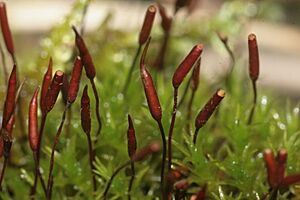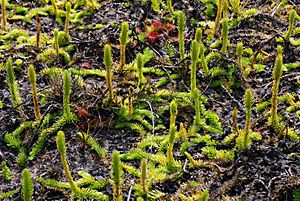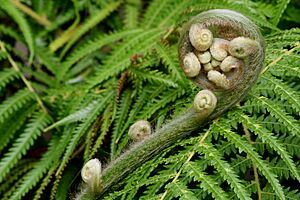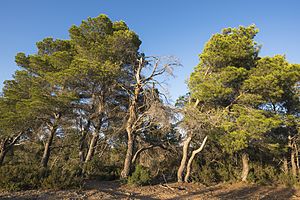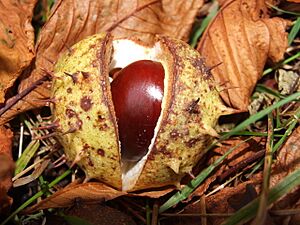Embryophyte facts for kids
Quick facts for kids Embryophyta |
|
|---|---|
| Scientific classification | |
| Kingdom: | |
| Subkingdom: |
Embryophyta
|
Embryophytes are what most people call land plants. These are the green living things you see on land, like trees, flowers, ferns, and mosses. They are different from algae, which mostly live in water. Embryophytes are a big group of plants that have adapted to live and grow on land. They include Bryophytes (like mosses) and vascular plants (like ferns and flowering plants).
Contents
Land Plants: The Embryophytes
Land plants are a huge and important group of living things. They are found almost everywhere on Earth, from hot deserts to cold mountains. They are essential for life because they produce the oxygen we breathe. They also provide food for many animals, including humans.
What Makes a Plant a Land Plant?
To live on land, plants needed to develop special features. Unlike algae, which are supported by water, land plants needed strong structures. They also had to find ways to get water and nutrients from the soil. Here are some key adaptations:
- Roots: These help plants anchor themselves and absorb water and minerals from the ground.
- Stems: Stems hold the plant upright and transport water and food.
- Leaves: Leaves are usually flat and green. They capture sunlight to make food through a process called photosynthesis.
- Cuticle: This is a waxy layer on leaves and stems. It helps prevent the plant from drying out in the air.
- Reproduction: Land plants developed ways to reproduce without needing to be fully submerged in water. Many use spores or seeds.
Different Kinds of Land Plants
There are many types of land plants, from tiny mosses to giant trees. Scientists group them based on their features. The two main groups are bryophytes and vascular plants.
Bryophytes: The Simple Land Plants
Bryophytes are the simplest land plants. This group includes mosses, liverworts, and hornworts. They are usually small and grow in damp places. They do not have true roots, stems, or leaves like other plants. Instead, they have simple structures that absorb water directly. Most bryophytes reproduce using spores.
Vascular Plants
Vascular plants are more complex than bryophytes. They have special tissues that act like tiny pipes. These pipes, called xylem and phloem, transport water, nutrients, and food throughout the plant. This allows vascular plants to grow much larger than bryophytes. Vascular plants are divided into two main groups: those that reproduce with spores and those that reproduce with seeds.
Ferns and Their Relatives
This group includes ferns, horsetails, and clubmosses. They have true roots, stems, and leaves. Like bryophytes, they reproduce using spores. Ferns are known for their beautiful, feathery leaves called fronds. They often grow in shady, moist environments.
Seed Plants (Gymnosperms and Flowering Plants)
Seed plants are the most common and diverse group of land plants. They reproduce using seeds, which protect the young plant embryo. Seeds allow plants to spread to new places and survive harsh conditions.
- Gymnosperms: These are "naked seed" plants. Their seeds are not enclosed within a fruit. Examples include pine trees, spruce trees, and cycads. Many gymnosperms have needles or scales instead of broad leaves.
- Flowering Plants (Angiosperms): These are the most diverse group of plants. They produce flowers and their seeds are enclosed within a fruit. This group includes almost all the plants we use for food, like fruits, vegetables, and grains. They also include most trees and shrubs you see every day.
Images for kids
See also
 In Spanish: Embryophyta para niños
In Spanish: Embryophyta para niños


